- (5mins)
Welcome and house rules






There is abundant evidence of anthropogenic environmental changes causing rapid evolution happening in all groups of organisms from bacteria to mammals. This is not yet incorporated in any future scenarios or model of environmental planning. Whether and how to promote such evolution or hamper it are key questions for fundamental science, policy and ethics. What’s more, novel substances such as microplastics, pharmaceuticals and long-lived compounds are being found in the environment with increasing regularity. No matter how effective the measures to control them will be in the future, they are already incorporated in many trophic chains and ecosystems and are likely to persist there for a long time. The ecological consequences of this situation are poorly known. We are also seeing the emergence of unprecedented (“novel”) ecosystems due to climate change, land use change, biological invasions, spontaneous colonisation of abandoned infrastructure, ocean gyres and artificial reefs: these are causing unprecedented combinations of species. One consequence of this is an increased risk to human health from zoonotic diseases such as Ebola and Lyme disease. At the same time, many protected areas face becoming obsolete because they are (or will soon be) no longer able to protect the living entities they were designed to protect. In fact, ecology researchers are being forced to come up with models that deal with the emerging reality where human and nonhuman coexistence and tolerance is forced, raising potential conflicts between human and nonhuman rights and creating dilemmas associated with how ecological theory and practice navigates these transitions in terms of ethics and logistics. Given this complexity, what breakthroughs can we expect in this field in the next 5, 10 and 25 years?


We are in an era of dramatic increase in our capacity to discover and monitor Earth’s biosphere. Coupled with AI, remote sensing and environmental molecular techniques will accelerate the discovery and monitoring of life, its location and its abundance, at huge scale and with an unprecedented level of detail. The emerging capacity to monitor new types of data such as sound and smell profiles are offering complementary datasets for ecosystems and communities. Ecological, environmental and biodiversity knowledge acquired by means other than the formal scientific methods, prominently Indigenous and local knowledge, is also being recognised as an important source of understanding. These forms of knowledge have 2025 Science Breakthrough Radar – Anticipation Workshop – Future of Ecology different validation criteria from the knowledge produced by formal science, and finding ways of validating them and “weaving” them together with formal science knowledge remains a challenge. Coming over the horizon is a suite of molecular, remote-sensing, laser scanning and quantum sensing techniques that will likely confer unprecedented capacity to record the state and trends of life on Earth. These may allow identification and monitoring of life from individuals to whole biomes with a previously unthinkable spatial coverage and detail. Examples include environmental DNA (eDNA), ecological functional genomics, high-resolution remote spectral recognition, terrestrial laser scanning, environmental bioacoustic and volatile profile detection, and increasingly small and smart individual tracking devices attached to mobile organisms. What breakthroughs can we expect these new tools to bring in the next 5, 10 and 25 years?


Our current ecological models are in need of a number of improvements. Ecosystem feedback mechanisms such as runaway permafrost melting and Amazon large-scale dieback are not yet incorporated in most climate models, for instance. Climate change overshoot is likely and yet there is no projection of how ecosystems will react. In addition, very few models deal with the intersection between these biophysical phenomena and economic-socio-political dynamics – large-scale displacement of people caused by armed conflict or climate change; the ecological consequences of market failures or political upheaval, for example, can all cause hard-to-model non-linearities in ecological and socio-ecological systems. There is also a need for models that take into account different philosophical approaches, such as envisioning a future of flourishing nature rather than a future of limited decline. Most models combining future nature protection and food production are based on the “sparing” strategy – intensified agriculture combined with highly protected areas – but what a “sharing” strategy at the global level might look like and what the consequences for human wellbeing might look like? There is also a need to diversify from models that incorporate economic parameters based on rational-agent economics; what would models based on other economic paradigms look like? There is also a need for AI-assisted global architectures to handle the different streams of environmental data. These would be able to produce much more detailed and ambitious models, including target-seeking ones that might highlight the best pathways to achieve such targets. On top of this, future models should seek to incorporate cross-system and cross-scale connections, enabling researchers to establish the role of ecological, economic and social connections across large (regional to global) spatial scales. For example, links between global supply chains, governmental subsidies, treaties and local decisions over how to use the land; links between societal values (diet, animal cruelty, fashion), land deforestation in remote regions, and global financial operations. Examples abound of these teleconnections, and they have been approached from disparate perspectives. However, to date there is no unified theory, framework or predictive power. Could this be rectified in the next 5, 10 or 25 years, and what other innovations and improvements might we achieve in our ecological models over these timescales?




